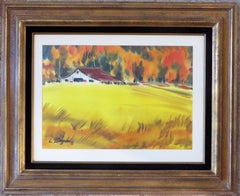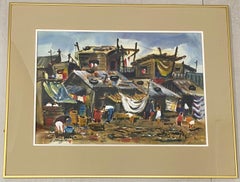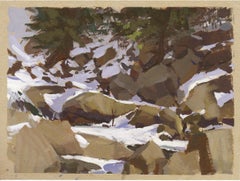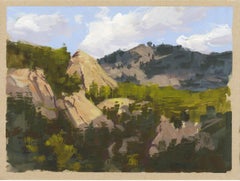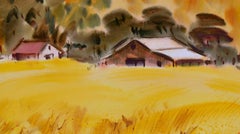Lewis Suzuki Landscape Paintings
Japanese, 1920-2016
Lewis Suzuki was born in Los Angeles, California of Japanese descent. As a boy of nine, Suzuki's father died (1929), and his mother returned to Japan with her six children. There, Suzuki excelled in the art programs in his primary school, attended Kawabata Art Academy in Tokyo, and began exploring the possibility of studying art in the U.S. In 1939, Suzuki moved back to Los Angeles, completed high school and took classes at Otis Art Institute,
In 1941, Suzuki moved to Washington, D.C., where he worked at the Japanese Embassy primarily as a “tea boy” and took classes at Corcoran School of Art. After the bombing of Pearl Harbor, all embassy officials were to return to Japan, but Suzuki wished to remain in the U.S.
He joined the U.S. Army and taught Japanese at the Military Intelligence Service Language School in Minnesota. After the war, he moved to New York, where he studied at the Art Students League and earned a living as a cabinet-maker.
Since the 1950's he resided in Berkeley, California and painted around the Bay Area. There, he specialized in city scenes, rural scenes, seascapes and floral still lifes, done with the wet-into-wet watercolor painting style.
Suzuki once said, “I feel that art has a place in enriching the life of humanity … Through my art, I try to strengthen that part of culture. And I feel that the arts should project the future of human society. To me, it cannot be non-objective or abstract in that sense.” He created a graphic work, “No More Hiroshimas,” and other peace posters for the American Friends Service Committee. Suzuki was a member of the politically active Graphic Arts Workshop from 1953 to 1963.
Suzuki’s bold and imaginative use of color won him numerous awards, including two at the Society of Western Artists show at the De Young Museum in San Francisco. He served on the Berkeley Art Commission and was recognized by the City of Berkeley in 2010. Until recently, he continued to work at his studio on Grant Street in Berkeley, participating in such events as East Bay Open Studios and Berkeley Artisans Holiday Open Studios. His work is well exhibited, listed, and collected.to
1
1
Overall Width
to
Overall Height
to
2
1
1
2
1
2
2
1
8
672
603
309
231
2
2
Artist: Lewis Suzuki
Autumn Landscape with Barn
By Lewis Suzuki
Located in San Francisco, CA
Artist: Lewis Suzuki (Japanese/American, 1920-2016)
Title: Autumn Landscape With Barn
Year: Circa 1970
Medium: Watercolor
Paper: Watercolor pap...
Category
1970s Impressionist Lewis Suzuki Landscape Paintings
Materials
Paper, Watercolor
Lewis Suzuki "Squatters in Manila" Original Watercolor C.1960
By Lewis Suzuki
Located in San Francisco, CA
Lewis Suzuki "Squatters in Manila" Original Watercolor C.1960
Original watercolor on paper
Dimensions 21" wide x 14" high
The frame measures 28.25" wide x 22.25" high
Signed in t...
Category
Mid-20th Century Lewis Suzuki Landscape Paintings
Materials
Watercolor
Related Items
"093 - Plein Air-Boulder Falls, CO" (2022) By Judd Mercer, Gouache Painting
By Judd Mercer
Located in Denver, CO
Judd Mercer's (US based) "093 - Plein Air-Boulder Falls, CO" is a gouache painting depicting a rocky landscape covered in snow during sunrise.
Artist bio/statement
Judd Mercer is a...
Category
2010s Impressionist Lewis Suzuki Landscape Paintings
Materials
Gouache, Paper
"024 - Plein Air-Horsetooth Rock, CO" (2022) By Judd Mercer, Gouache Painting
By Judd Mercer
Located in Denver, CO
Judd Mercer's (US based) "024 - Plein Air-Horsetooth Rock, CO" is a gouache painting depicting mountainside with lush wilderness.
Artist bio/statement
Judd Mercer is a contemporary ...
Category
2010s Impressionist Lewis Suzuki Landscape Paintings
Materials
Gouache, Paper
"046 - Plein Air-Star K Ranch, CO" (2022) By Judd Mercer, Gouache Painting
By Judd Mercer
Located in Denver, CO
Judd Mercer's (US based) "046 - Plein Air-Star K Ranch, CO" is a gouache painting depicting a forest.
Artist bio/statement
Judd Mercer is a contemporary landscape painter and Color...
Category
2010s Impressionist Lewis Suzuki Landscape Paintings
Materials
Gouache, Paper
"044 - Plein Air-Englewood, CO" (2022) By Judd Mercer, Gouache Painting
By Judd Mercer
Located in Denver, CO
Judd Mercer's (US based) "044 - Plein Air-Englewood, CO" is a gouache painting depicting a forest.
Artist bio/statement
Judd Mercer is a contemporary landscape painter and Colorado...
Category
2010s Impressionist Lewis Suzuki Landscape Paintings
Materials
Gouache, Paper
"098 - Plein Air-Morrison, CO" (2022) By Judd Mercer, Gouache Painting
By Judd Mercer
Located in Denver, CO
Judd Mercer's (US based) "098 - Plein Air-Morrison, CO" is a gouache painting depicting a rocky landscape with light snow cover.
Artist bio/statement
Judd Mercer is a contemporary ...
Category
2010s Impressionist Lewis Suzuki Landscape Paintings
Materials
Paper, Gouache
"Foothills in Shadow, " Gouache Painting
By Judd Mercer
Located in Denver, CO
Judd Mercer's (US based) "Foothills in Shadow," is an original, handmade gouache painting that depicts a yellow grassy valley as it intersects with snow du...
Category
2010s Impressionist Lewis Suzuki Landscape Paintings
Materials
Gouache
"096 - Plein Air-Morrison, CO" (2022) By Judd Mercer, Gouache Painting
By Judd Mercer
Located in Denver, CO
Judd Mercer's (US based) "096 - Plein Air-Morrison, CO" is a gouache painting depicting a snowy landscape.
Artist bio/statement
Judd Mercer is a contemporary landscape painter and ...
Category
2010s Impressionist Lewis Suzuki Landscape Paintings
Materials
Paper, Gouache
"001 - Plein Air- Lair o the Bear, CO" (2022) By Judd Mercer, Gouache Painting
By Judd Mercer
Located in Denver, CO
Judd Mercer's ( US based) "001 - Plein Air- Lair o the Bear, CO" is a gouache painting depicting a peaceful snowy naturescape.
Artist bio/statement
Judd Mercer is a contemporary la...
Category
2010s Realist Lewis Suzuki Landscape Paintings
Materials
Gouache, Paper
"095 - Plein Air-Morrison, CO" (2022) By Judd Mercer, Gouache Painting
By Judd Mercer
Located in Denver, CO
Judd Mercer's (US based) "095 - Plein Air-Morrison, CO" is a gouache painting depicting a snowy forest.
Artist bio/statement
Judd Mercer is a contemporary landscape painter and Col...
Category
2010s Impressionist Lewis Suzuki Landscape Paintings
Materials
Paper, Gouache
"084 - Plein Air-Glenwood Springs, CO" (2022) By Judd Mercer, Gouache Painting
By Judd Mercer
Located in Denver, CO
Judd Mercer's (US based) "084 - Plein Air-Glenwood Springs, CO" is a gouache painting depicting a snowy mountain landscape with a small frozen lake at the bottom.
Artist bio/statem...
Category
2010s Impressionist Lewis Suzuki Landscape Paintings
Materials
Gouache, Paper
"089 - Plein Air-Four Mile Park, CO" (2022) By Judd Mercer, Gouache Painting
By Judd Mercer
Located in Denver, CO
Judd Mercer's (US based) "089 - Plein Air-Four Mile Park, CO" is a gouache painting depicting a colorful landscape with trees overhanging a river.
Artist bio/statement
Judd Mercer ...
Category
2010s Impressionist Lewis Suzuki Landscape Paintings
Materials
Gouache, Paper
"035 - Plein Air-Flat Irons Vista, CO" (2022) By Judd Mercer, Gouache Painting
By Judd Mercer
Located in Denver, CO
Judd Mercer's (US based) "035 - Plein Air-Flat Irons Vista, CO" is a gouache painting depicting a few large trees in a valley.
Artist bio/statement
Judd Mercer is a contemporary la...
Category
2010s Impressionist Lewis Suzuki Landscape Paintings
Materials
Gouache, Paper
Previously Available Items
Country Barn Watercolor Landscape
By Lewis Suzuki
Located in Soquel, CA
A vibrant rural watercolor scene by Lewis Suzuki (American, 1920-2016). Artist's signature "L. Suzuki" and chop lower left. Suzuki is considered an important figure in the watercolor...
Category
1970s American Impressionist Lewis Suzuki Landscape Paintings
Materials
Watercolor, Rag Paper
Lewis Suzuki landscape paintings for sale on 1stDibs.
Find a wide variety of authentic Lewis Suzuki landscape paintings available for sale on 1stDibs. You can also browse by medium to find art by Lewis Suzuki in paint, watercolor, paper and more. Much of the original work by this artist or collective was created during the 20th century and is mostly associated with the Impressionist style. Not every interior allows for large Lewis Suzuki landscape paintings, so small editions measuring 29 inches across are available. Customers who are interested in this artist might also find the work of Clifford Holmes, Henri Miloch, and Jesse Don Rasberry . Lewis Suzuki landscape paintings prices can differ depending upon medium, time period and other attributes. On 1stDibs, the price for these items starts at $650 and tops out at $1,100, while the average work can sell for $875.
